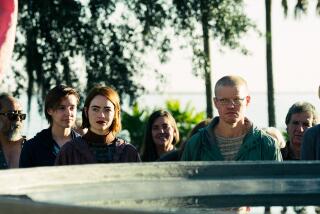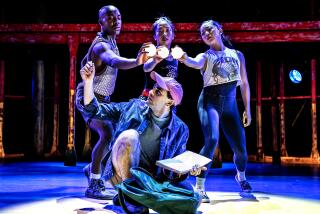DANCE REVIEW : Malashock’s Bold, Juicy Nihilism
Whether he’s experimenting with narrative or expressing his feelings about music, choreographer John Malashock always creates a feverish sense of disintegration. Trust him to show the fatal flaw, the canker in the rose, the process of destruction hidden within an illusion of wholeness.
At Cal State Long Beach on Tuesday, this former Twyla Tharp dancer presented his accomplished, five-member, San Diego-based modern-dance ensemble in three works from 1991. Each offered bold, juicy movement invention on a grand theatrical scale (Malashock has never been what you’d call a studio choreographer). Each also carefully examined, and then extinguished, the possibility of hope in contemporary life.
Reviewed in these pages at their La Jolla premieres last May, both “The Barn Owl Lingers” and “Apologies From the Lower Deck” focus on fragmentation. The plotless “Barn Owl” (music by Janacek) begins in sensitive, almost balletic lyricism. However, before long, hand-spasms break through the flowing unison patterns and grotesque partnering gambits shatter any lingering delusion that this is classical dance.
By the end, with everyone doing shivery push-ups, the breakdown is complete: Movement shape has vanished and only pure motor impulse remains. Adding to the impact: new costumes by Deborah Dryden that keep the weight and edge of Malashock’s ideas more prominent than the prettier originals did.
Incorporating a score by Mark Attebery and a text by Michael Erickson, “Apologies” depicts five orphaned cousins on a fatal journey, with actor Steve Pearson moving among the dancers to comment on their characters’ perspectives.
Very quickly, we sense their deepest secrets and glimpse the fate awaiting them. Malashock not only works intuitively here but with a knack for layered text and movement statements: testimony and commentary, documentary, daydream and nightmare all laminated in potent theater images.
With the text sometimes muffled on Tuesday, the rich, supple, nonstop movement became even more prominent--especially toward the end when the dancers must represent not only the cousins but the surging ocean that consumes them.
Introduced last November, “Where the Arrow Landed” catches the elegance and sensuality of music by Villa-Lobos in a series of duets, trios and ensembles emphasizing same-sex partnering. At the left of the stage: a low, circular railing, painted red, that extends into the wings. At the back: a large painting by Pamela DeLaura showing not only that railing but a clawlike hand, one of the work’s central choreographic motifs.
Dances within the railing area and outside it suggest the oppressive confinement of interior space versus the relative liberation of the outdoors. However, the black costumes, the imploring hands reaching into the sky and the mournful slumps onto the railing establish a shared malaise. Finally, as usual, Malashock’s people manipulate one another to ever-higher plateaus of pain.
In his intense opening duet with Greg Lane, Malashock looks as commanding as ever. However, he no longer eclipses his company members. Lane, Debi Toth, Maj Xander and Loni Palladino all embody his style with equal authority and make his dark vision a powerful communal declaration.
More to Read
The biggest entertainment stories
Get our big stories about Hollywood, film, television, music, arts, culture and more right in your inbox as soon as they publish.
You may occasionally receive promotional content from the Los Angeles Times.










